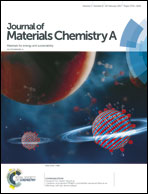Spontaneous nanoparticle formation coupled with selective adsorption in magadiite†
Abstract
The applications of hydrated layered polysilicates, particularly magadiite, have rapidly expanded from selective cation adsorption to fabrication of nanomaterials even without full understanding of their adsorption reactions. This study has successfully elucidated the distinguished adsorption behavior of magadiite, spontaneous nanoparticle formation coupled with selective adsorption reactions. Magadiite exhibited highly reliable and selective adsorption, especially for Cu2+ and Pb2+. The adsorbed heavy metal cations besides Cu2+ and Pb2+ were spontaneously and systematically transformed into the corresponding hydroxide nanoparticles exclusively on the crystal edges and the nanoparticles ultimately sprouted out of the crystals on full growth. Cation selectivity is explained by the compatibility of the interlayer silanol configuration with coordination of the adsorbed cations whereas spontaneous nanoparticle formation by the changes of the silanol configuration through the grafting reaction of the adsorbed cations is due to the high flexibility of the silicate frameworks. These unique adsorption behaviours of hydrated layered polysilicates, particularly magadiite, provide a new strategy not only for developing advanced purification/retrieval technologies but also for tailor-making various nanoparticles.


 Please wait while we load your content...
Please wait while we load your content...